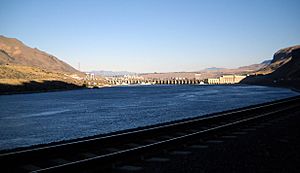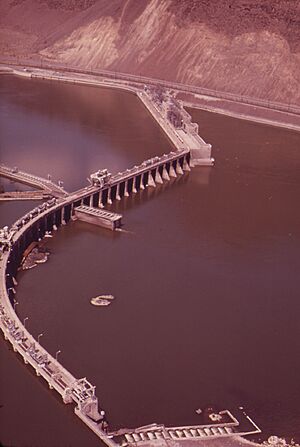Rock Island Dam facts for kids
Quick facts for kids Rock Island Dam |
|
|---|---|

Rock Island Dam from Washington SR 28
|
|
| Location | Chelan / Douglas counties, Washington |
| Coordinates | 47°20′32″N 120°05′41″W / 47.342155°N 120.094773°W |
| Construction began | 1930 |
| Opening date | 1933 |
| Dam and spillways | |
| Impounds | Columbia River |
| Reservoir | |
| Creates | Rock Island Pool |
| Total capacity | 131,000 acre⋅ft (0.162 km3) |
| Power station | |
| Turbines | 19 |
| Installed capacity | 623.7 MW |
| Annual generation | 2,600 GWh |
The Rock Island Dam is a large structure built across the Columbia River in Washington, United States. It's a special kind of dam called a hydroelectric dam. This means it uses the power of flowing water to create electricity.
The Rock Island Dam was the very first dam to be built across the mighty Columbia River. Its construction started in 1929 and finished in 1933. You can find it about 12 miles (19 km) downstream from the city of Wenatchee. The water held back by the dam forms a lake called the Rock Island Pool.
Contents
What is the Rock Island Dam?
The Rock Island Dam sits on very strong rock called Columbia River basalt. This type of rock was formed from ancient lava flows millions of years ago. It's super strong and durable, making it a perfect and stable base for the dam.
The Columbia River flows through this area with a lot of power. This powerful flow is what the dam uses to generate electricity for homes and businesses.
How the Dam Makes Electricity
The Rock Island Dam is a big power producer. It has many large machines called turbines that spin when water rushes through them. These spinning turbines then power generators that create electricity.
For example, in 2001, the dam produced 1,900 gigawatt-hours of electricity. A gigawatt-hour is a huge amount of power, enough to supply many thousands of homes! On average, the dam produces about 2,600 gigawatt-hours each year.
The dam has two main powerhouses. The Second Powerhouse, built later, produces most of the electricity. In 2001, it made 95% of the dam's total power.
Helping Salmon
Sometimes, to help young salmon safely pass the dam, some water is allowed to spill over the dam instead of going through the turbines. This helps the fish survive their journey. For example, during one period, a lot of water was spilled to help the salmon. This means less electricity was made during that time, but it's important for protecting the fish.
Building the Dam
The idea for the Rock Island Dam started in 1927. Engineers saw that this spot on the Columbia River had great potential to create electricity for the growing areas nearby.
In 1929, a company called Washington Electric Company got permission to build the dam. Construction began on January 14, 1930. This was right at the start of the Great Depression, a tough economic time. Even so, the dam was completed quickly, and its first parts started working on February 1, 1933.
Growing Over Time
The Rock Island Dam project grew over about 50 years. There were three main building phases, each about 20 years apart. This happened as more and more electricity was needed in the region.
- First Phase (1930-1933): The first dam, powerhouse, and four power-generating units were built.
- Second Phase (1951-1953): The dam and powerhouse were expanded, and six more power units were added.
- Third Phase (1974-1979): A completely new Second Powerhouse was built on the west side of the river. This added eight more turbine generators, greatly increasing the dam's power.



